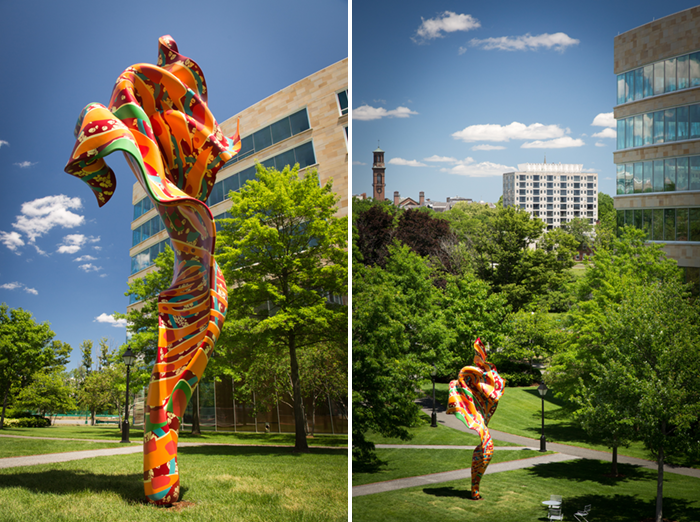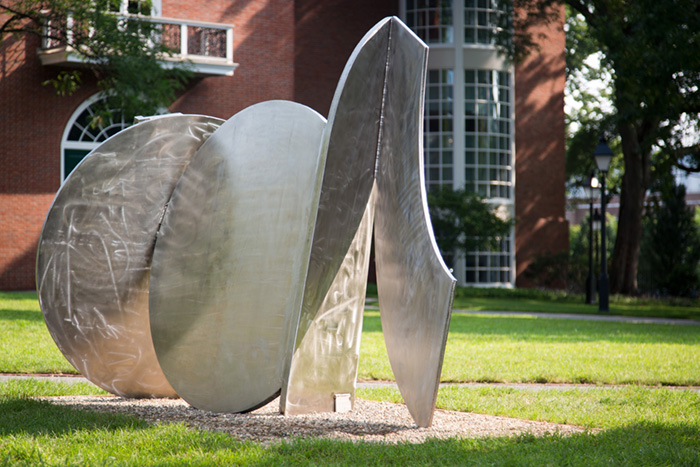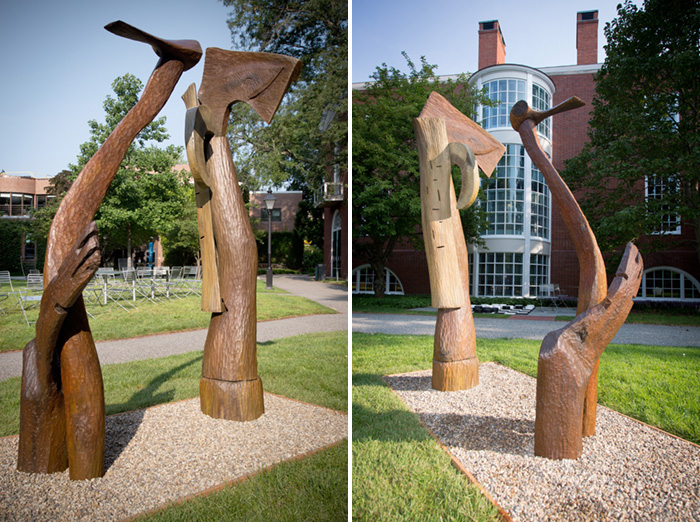Harvard Business School Announces New Pieces Added to the Public Art Exhibition Supported by the C. Ludens Ringnes Sculpture Collection
|
BOSTON—Four sculptures have been installed on Harvard Business School’s (HBS) campus in Boston as part of its ongoing contemporary sculpture program, which began in April 2016. A sculpture by Yinka Shonibare CBE RA is a new addition to the C. Ludens Ringnes Sculpture Collection, and a sculpture by Melvin Edwards and two works by Thaddeus Mosley are on loan to the School for the 2021-2022 exhibition. They join sculptures by Mary Frank, Jaume Plensa, John Safer, and Joel Shapiro in the School’s permanent collection. “We’re excited to have works by these artists here on campus,” said Melissa Renn, collections manager, HBS Art and Artifacts Collection. “Their dynamic sculptures, sited on Schwartz Common where our whole community intersects and near the hub for Executive Education, which draws so many international participants, energize our outdoor spaces. It is a wonderful opportunity for the community to engage with works of art from around the world.” These installations are made possible by the generosity of the artists and galleries, including Alexander Gray Associates, Stephen Friedman Gallery, James Cohan Gallery, and Karma, and by the C. Ludens Ringnes Sculpture Collection, which supports Harvard Business School’s contemporary outdoor sculpture exhibition. “We are extremely grateful to Christian Ringnes (MBA 1981) for his generous gift which established the collection in 2018,” said Gabe Handel, assistant dean for administrative and educational affairs. “Through this support, we have been able to not only make permanent investments, but also launch thoughtful temporary exhibits, elevating the campus experience for everyone, whether members of our residential community or visitors from far and wide. These wonderful installations create a sense of wonderment, highlight important themes, spark conversations, reinforce appreciation for the arts, and make the campus more engaging overall.” More information on the collection can be found on the school’s website for Contemporary Art at HBS, which includes a map featuring sculptures currently on display outdoors across the HBS campus. This year’s installation features the following works:

Yinka Shonibare CBE RA, Wind Sculpture (SG) V, 2019, stainless steel armature with hand painted, glass reinforced polyester cast, 275 1/2 × 100 × 78 5/8 in. C. Ludens Ringnes Sculpture Collection, Harvard Business School © 2021 Yinka Shonibare CBE. All Rights Reserved, DACS/ARS, NY 2021 Location: Executive Education Lawn Born in London in 1962, Yinka Shonibare moved to Lagos, Nigeria, at age three. He returned to the UK to study fine arts at the Byam Shaw School of Art in London, and Goldsmiths, University of London, where he received his MFA. Shonibare’s work examines the interrelationship of African and European economic and political histories, colonialism, post-colonialism, and globalization. Much of his work uses brightly colored Dutch wax batik fabric, which was inspired by Indonesian design, mass-produced by the Dutch, and then sold to the colonies in West Africa. In the 1960s, the material became a symbol of African identity and independence. As Shonibare has stated, “Based on the history of the fabrics, I wanted to actually evoke that connection between Asia, Africa and Europe—and of course the diaspora in the United States.” Wind Sculpture (SG) V was acquired by Harvard Business School in 2021 for the C. Ludens Ringnes Sculpture Collection. In this work, Shonibare employs Dutch wax textiles to visualize the idea of capturing the volume of wind. Constructed of industrial materials, the monumental, hand-painted 22-foot-high sculpture is based on photographs of wind being blown into the actual batik fabrics. Shonibare has expressed his aim with the Wind Sculpture series: “I wanted to defy gravity. To do something that actually looks soft, but it’s made out of hard materials, like fiberglass and metal.” Wind Sculpture (SG) V previously was installed on the Rose Kennedy Greenway in Boston, and other sculptures from the series have been installed in locations around the world, including Trafalgar Square, London; Central Park, New York; Ndubuisi Kanu Park, Lagos, Nigeria; Smithsonian National Museum of African Art, Washington, DC; and Davidson College, North Carolina. Nominated for the Turner Prize in 2004, Shonibare was also featured in the 52nd Venice Biennale in 2007. He was elected a Royal Academician (RA) in 2013, and in 2019 was awarded the Commander of the Order of the British Empire (CBE). His sculptures are in the collections of the Victoria and Albert Museum, London; Museum of Modern Art, New York; Moderna Museet, Stockholm; National Gallery of Canada, Ottawa; Tate Collection, London; and VandenBroek Foundation, The Netherlands. He is represented by James Cohan Gallery in New York and Stephen Friedman Gallery in London. 
Melvin Edwards, Searching for the Word, 1989/2019, stainless steel, 72 × 116 × 59 in. Courtesy Alexander Gray Associates, New York, and Stephen Friedman Gallery, London. © 2021 Melvin Edwards/Artists Rights Society (ARS), New York Location: Schwartz Common Born in 1937 in Houston, Melvin Edwards moved to New York in 1967. In 1970, he became the first African American sculptor to have a solo exhibition at the Whitney Museum of American Art, and in 1978 he had a retrospective at The Studio Museum in Harlem. Best known for his Lynch Fragments—small abstract sculptures variously formed from tools, chains, railroad spikes, and steel scraps—Edwards works in a wide range of media, from barbed-wire installations to large-scale painted steel sculptures. His powerful and moving sculptures engage with history and politics, exploring such themes as violence, injustice, struggle, and civil rights. Searching for the Word is based on an earlier 1989 maquette Edwards created for New York's Governor’s Arts Awards and recalls his other public sculptures from the same period, such as Southern Sunrise (1983) and Breaking of the Chains (1995). Composed of stainless-steel shapes and curvilinear forms, these works ideally are viewed in the round, for as Edwards describes, “A person will be able to experience them the way they experience architecture—that is, they move through and around and have a different visual experience from every point of view of the piece.” For Edwards, public sculptures are also interventions that can transform public spaces and inspire action. As he wrote in his 1971 statement, “Notes on Black Art”: “We must make works that use our lives and feelings as their basis for existence. The work can either take the form of giving and using ideas, subjects and symbols for radical change, or the works can be of such large physical scale, and in the right places as to make real change.” Edwards’s work has been featured in numerous exhibitions and is in the collections of the Brooklyn Museum; Los Angeles County Museum of Art; Metropolitan Museum of Art; Museum of Fine Arts, Houston; Museum of Modern Art, New York; San Francisco Museum of Modern Art; The Studio Museum in Harlem; and Whitney Museum of American Art, among others. Edwards taught at Rutgers University from 1972 to 2002, and in 2014 he received an honorary doctorate from the Massachusetts College of Art in Boston. He is represented by Alexander Gray Associates, New York, and Stephen Friedman Gallery, London. 
Thaddeus Mosley, Illusory Progression, 2020, bronze, 94 × 34 × 20 in., and Rhizogenic Rhythms, 2020, bronze, 82 × 32 × 35 in. Courtesy of the artist and Karma, New York © 2021 Thaddeus Mosley Location: Schwartz Common Self-taught artist Thaddeus Mosley was born in 1926 in New Castle, Pennsylvania. After graduating from high school, he enrolled in the U.S. Navy. He went on to major in English and journalism at the University of Pittsburgh and graduated in 1950. Mosley worked for the U.S. Postal Service for 40 years and wrote for the Pittsburgh Courier, one of the nation’s leading Black newspapers. In the 1950s Mosley began making sculptures, and in 1968 he had his first solo exhibition at the Carnegie Museum of Art. Using wood from reclaimed building materials and local sawmills, as well as fallen logs sourced from Pittsburgh’s Forestry Division, Mosley’s carved abstractions, or “sculptural improvisations,” as he calls them, show the influence of jazz on his artistic process. He often listens to music while he sculpts. “My woods and stones and I generate themes together,” Mosley says. At age 95, Mosley continues to work in his studio six hours a day. Illusory Progression and Rhizogenic Rhythms were commissioned for the 2020 Frieze Sculpture exhibition at Rockefeller Center in New York. Carved out of salvaged timber and then cast in bronze, these biomorphic sculptures playfully interact with one another and their surroundings. Mosley’s inventive works not only push the boundaries of the medium, but also engage with the history of sculpture. As the artist has described, “One of the most important aspects of my own work is how different segments interact. Because of [sculptor Isamu] Noguchi, I’ve aimed for work that levitates or is slightly off balance.” Mosley has received numerous commissions over the years, including a public sculpture for Pittsburgh’s Urban Redevelopment Authority in 1978. He has been an officer for the Pittsburgh Society of Sculptors and a board member of the August Wilson African American Cultural Center. Mosley’s work has been exhibited and acquired by major museums and can be found in many public collections, including the Mattress Factory museum, Martin Luther King Jr. Reading and Cultural Center, and Carnegie Museum of Art, all in Pittsburgh; Art Institute of Chicago; High Museum of Art in Atlanta; and Brooklyn Museum. He is represented by Karma, New York. |
Media
Mark Cautela
mcautela+hbs.edu
(617) 495-5143
Art Exhibits
Melissa Renn
mrenn+hbs.edu
(617) 384-5657
About Harvard Business School
Harvard Business School, located on a 40-acre campus in Boston, was founded in 1908 as part of Harvard University. It is among the world's most trusted sources of management education and thought leadership. For more than a century, the School's faculty has combined a passion for teaching with rigorous research conducted alongside practitioners at world-leading organizations to educate leaders who make a difference in the world. Through a dynamic ecosystem of research, learning, and entrepreneurship that includes MBA, Doctoral, Executive Education, and Online programs, as well as numerous initiatives, centers, institutes, and labs, Harvard Business School fosters bold new ideas and collaborative learning networks that shape the future of business.
